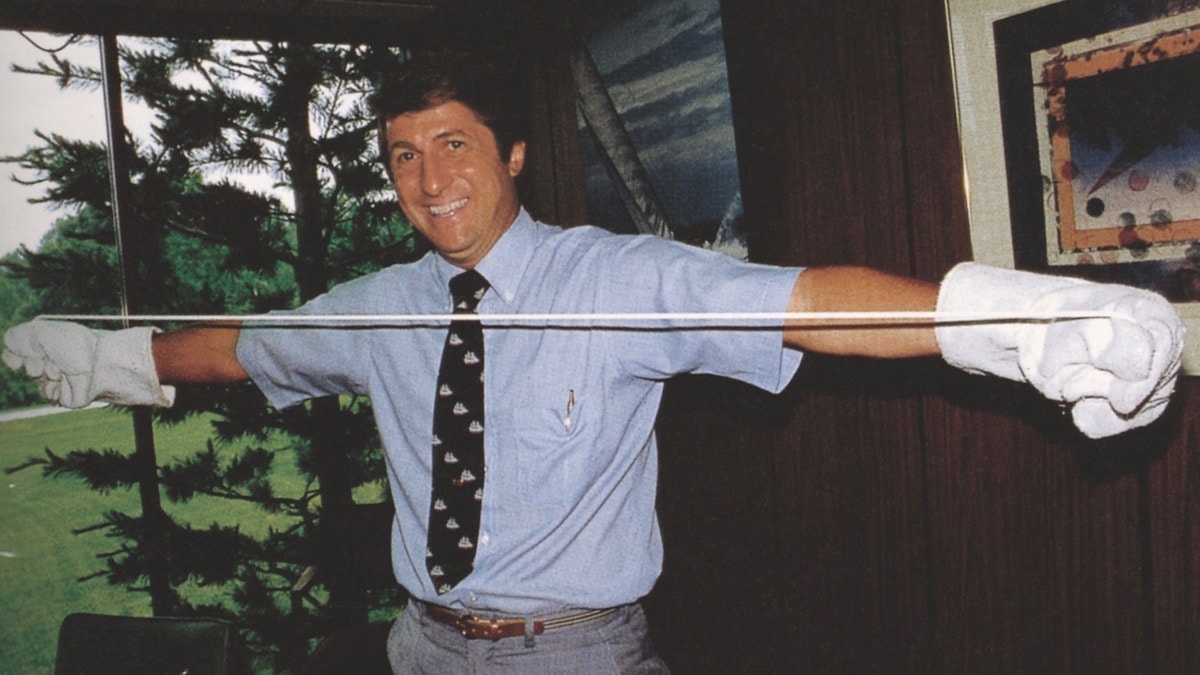On an October evening in 1969, Robert “Bob” Gore was working alone in the lab of W.L. Gore & Associates, experimenting with a polymer called PTFE. He and others at the company wanted to figure out how to stretch pipe-thread tape so it would go farther and save material costs. But they hadn’t had much luck, even using a new machine. So, Gore decided to try it by hand, stretching it slowly at first. Frustrated that the material kept breaking, he gave it a quick yank. He was stunned: It stretched the length of his arms.
From that hands-on experiment, the initial GORE-TEX technology was born. Gore had discovered a lightweight but strong and porous material—expanded PTFE—which lead to the development of waterproof, breathable GORE-TEX products that have become standards in performance outdoor gear. It’s also used in many other industries and applications, including NASA spacesuits, computer and telecommunications cables, guitar strings and implantable medical devices like cardiac patches.
Gore, an inventor, chemical engineer and philanthropist who served as president, board chairman and chairman emeritus of W.L. Gore & Associates, died at the age of 83 on Sept. 17 at his home in Newark, Delaware, following a long illness, the company announced.
“His passion for the quality and performance of our products and his incisive questions and insights shaped not only the culture of our technology efforts but the values at the core of who we are,” Jason Field, CEO of Gore, said in a statement.
From 1976 to 2000, Gore served as president of the company that his parents, Wilbert “Bill” and Genevieve “Vieve,” started in the basement of their Delaware home in 1958. W.L. Gore & Associates, based in Newark, Delaware, has grown today to more than 11,000 employees worldwide and annual revenues of more than $3 billion.

Bob Gore at a chalkboard. Photo courtesy of W. L. Gore & Associates
Gore’s legacy
The company is best known for its waterproof, breathable gear, including rainwear and tents. A Seattle company called Early Winters, Ltd. made the first GORE-TEX parka in the late 1970s. An Early Winters catalog touted its “impressive protection from wind, water and your own body’s moisture.”
“Gore-Tex is outdoor outerwear,” Chris Harges, director of brand for Marmot, wrote in an email to the Co-op Journal. “The invention of Gore-Tex changed the way people understood clothing. It marks the moment when brands and consumers began to talk about technology and apparel in the same context. It’s akin to what happened in personal computing. All of a sudden, the sort of space-age technologies that you associated with NASA [were] available to everyone.”
Marmot became one of the original customers of GORE-TEX, making the first sleeping bag using the new waterproof membrane. The brand was in its early years when co-founder Eric Reynolds had met with a Gore associate in 1976 and became intrigued with the new GORE-TEX fabric, as Marmot tells it. Reynolds and co-founder Dave Huntley then had prototype sleeping bags sewn up and tested under fire sprinklers. They also spent seven nights in a commercial frozen meat locker comparing bags with and without GORE-TEX before giving it their stamp of approval. Soon after, Marmot made tents, sleeping bags, jackets and pants using the fabric.

Photo Courtesy of Marmot
Susan Viscon, senior vice president of Merchandising and Co-op Brands at REI, recalled visiting Gore headquarters 20 years ago as an outerwear buyer. “There was innovation at every corner, full commitment to quality, interactive testing and a steadfast belief that retailers needed to be knowledgeable,” she said. “Although I didn’t meet Bob, the day with the team reinforced that they shared his commitment to innovation and the feeling that they were all equals doing this important work. The outdoor industry benefited and grew from GORE-TEX becoming a household name for waterproof performance.”
Early life
Gore was born in Salt Lake City on April 15, 1937, the oldest of five children. As a teen, he played the trombone, participated in sports and served in student government, the company said.
While a sophomore at the University of Delaware, Gore came up with an idea for a multi-conductor wiring strip. His father, who worked at the chemical company DuPont, had been tinkering with PTFE, commonly known as Teflon. Gore suggested a way to make it adhere around wires. That strip, used in early computers, was the first of Gore’s nine patents and helped his parents kick-start W. Gore & Associates.
After earning his master’s and doctoral degrees in chemical engineering from the University of Minnesota, Gore joined his parents’ business in 1963. He succeeded his father as president and CEO in 1976. Also, he served 30 years as chairman of the company’s board.
Among his achievements, Gore was elected to the National Academy of Engineering and was inducted into the National Inventors Hall of Fame in 2006.
Gore is survived by his wife, Jane, as well as children, grandchildren and great-grandchildren and four siblings.
